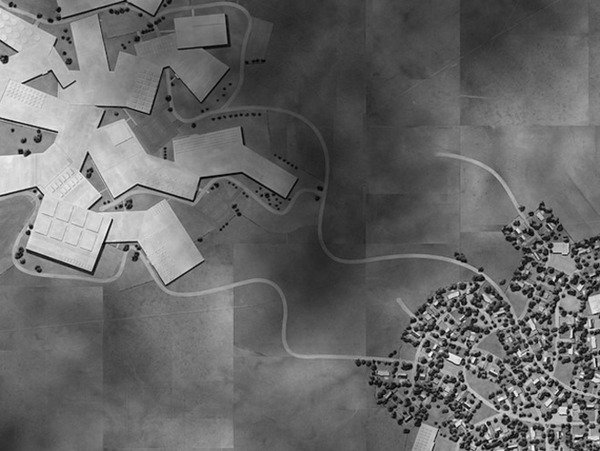Revision Peripherique
dal 20/10/2011 al 18/11/2011
Segnalato da
James Reeder
Jeremie Lenoir
The Arbour Lake Sghool
Ross Racine
Heather Johnson
Jo Q Nelson
20/10/2011
Revision Peripherique
Projective city, Paris
Six artists explore re-visions of the urban environment, document suburban realities, collide elements from different urban/rural environments, and/or take the city itself as a creative material with which to develop new work.

The circular road that surrounds Paris, known as La Peripherique, is more than a crucial conduit for Parisian commuters who seek to use one of its numerous “portes”. The motorway also plays an important role as a boundary, clearly delineating what to many people counts as “Paris” and what counts as “The Suburbs”. As such, the road functions as a useful emblem of the increasingly important political tensions between “centers” and “peripheries”. Older, familiar dichotomies between rich and poor, male and female, proletariat and bourgeoisie, even self and other are increasingly seen as parts of a larger dialectical relationship between ever-shifting centers and peripheries, and it is this relationship which is key to understanding our contemporary political reality.
Taking advantage of its location near La Peripherique, (and on the periphery of the Parisian art scene), “Revision Peripherique” concentrates on the interplay of center and periphery at stake in contemporary cities. Six artists explore re-visions of the urban environment, document suburban realities, collide elements from different urban/rural environments, and/or take the city itself as a creative material with which to develop new work. Cities as centers of connection and activity are reconsidered in the context of their peripheries, re-created in fantastic plans and models, and introduced to one another through romantic gestures and exchanges.
Ross Racine
Racine appears to present aerial pencil drawings of quotidian American suburbs, but on closer view, things are not as they seem. For starters, the work is drawn entirely on a computer using no guides or sketches. But perhaps more importantly, the spaces depicted are wildly fantastic, the work of an urban planner turned madman. Roads lead nowhere, houses are impossibly jammed together or kept extremely remote, and geometrical precision or sheer whimsy seems to take priority over utility. Racine’s work is particularly effective as it can equally well be read as witty playfulness or as a thoughtful critique of ubiquitous suburban sprawl.
James Reeder
Reeder’s work frequently draws inspiration from different ideas of the city. In both his photography and his sculptural work, built environments are presented as responses to a mysterious natural world from which it emerges, maintains its form and eventually returns to. The materials, while meticulously fashioned, are generally commonplace, and no attempt is made to hide the supports and wires that keep things together. Styrofoam quarries produce the building blocks from which such fragile cities could be erected, and whiffs of cotton function as the steam and smoke from their rooftops. Urban space is thus presented as ephemeral, transitory, and only just barely real.
Jo Q Nelson
Nelson’s work frequently involves investigations of our relationship with built spaces. Most recently, her practice includes developing “people-specific” projects based on conversations with the inhabitants and users of various environments, from working people to residents to children. For Revision Peripherique, she has collaborated with Projective City director Benjamin Evans in an attempt to generate a site specific project from afar. Through conversations and material documentation of the neighborhood around the gallery, Nelson presents an idea of a place she has not been, a 13th arrondisment of the imagination.
Jeremie Lenoir
Lenoir’s areal photography presents our world in an entirely different context. The interventions of humans on the earth itself are rendered visible on a grand and sublime scale. As critique, the work is ambiguous, as typical eyesores (such as sprawling parking lots and open-pit mines) are rendered beautiful. At the same time, this apparently straightforward documentary process (there is no digital manipulation involved) involves a transformation not merely into something beautiful, but into something that is almost unreal. Operating at a scale we are unfamiliar with, the images become complicated contradictions of concrete and abstract, real and unreal, beautiful and sublime.
The Arbour Lake Sghool
Based in a suburban home in the Canadian city of Calgary, this loosely-organized collective takes suburban experience as its generative principle, at least most of the time. Responding to the staggeringly fast repurposing of rural land by new suburban “developments”, the group decided to revert their front lawn back into a wheat-field. Reconnecting with the food chain in a laboriously literal way, the group plowed, planted, maintained and harvested the crop in a confounding, romantic and absurd gesture that sparked considerable controversy in the conservative and placid neighborhood. For Revision Peripherique, the group presents documentation of this project as well as a new site specific installation based on the suburban fixation with lawn care.
Heather Johnson
Like Nelson’s, Johnson’s work frequently engages with the experiences of humans in the built environments they inhabit. Literally weaving together topographical maps with fragments of thought and conversation from various sources, Johnson creates an unsettling juxtaposition of inhabitant and habitat. For Revision Peripherique, Johnson has also developed a site specific project as a connective gesture between the cities of New York and Paris. Fragmentary sensory impressions of each city were collected from the residents of one city about the other. These fragments were then sewn into handkerchiefs, and, following the 18th century tradition in which women would drop lace hankies in hopes that certain young men might pick them up, the hankies about New York will be dropped around Paris (and vice versa) in a flirtatious gesture of initiating contact.
Benjamin Evans
Opening Friday, October 21 6 p.m.
Projective city
34, rue Helene Brion - Paris



